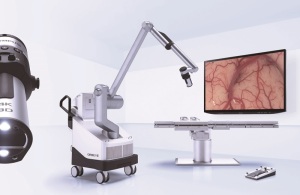by
John R. Fischer, Senior Reporter | October 10, 2017

ORBEYE is designed to reduce
fatigue and increase accuracy during
surgeries
Surgeons may feel less fatigue and feel more confident during procedures following the launch of Olympus’s 4K-3-D microscope, ORBEYE at the Congress of Neurological Surgeons (CNS), taking place between October 7 and 11 in Boston.
The device, a joint collaboration between Olympus Corporation and Sony Imaging Products & Solutions Inc, provides 3-D imaging of the structure of tissue, blood vessels and other features while allowing the entire surgical team to view the progression of procedures through a 55-inch monitor, ensuring less fatigue and greater accuracy.
“Surgeons and assistants can work side by side in the same orientation and have an immersive surgical experience due to magnified surgical site 3-D images,” James B. Lockwood, the director of marketing for video microscopy at Olympus America Inc., told HCB News. “It offers an educational advantage and is a valuable tool for surgeon training and education.”




Ad Statistics
Times Displayed: 44187
Times Visited: 1363 Keep biomedical devices ready to go, so care teams can be ready to care for patients. GE HealthCare’s ReadySee™ helps overcome frustrations due to lack of network and device visibility, manual troubleshooting, and downtime.
Traditional surgical microscopes require multiple people and take considerable time to set up and adjust. ORBEYE is 95 percent smaller in volume and 50 percent lighter than previous microscopes, providing additional space for surgeons to conduct procedures, and shortening setup time by eliminating the need to awkwardly adjust the arm. It also only requires one person for easy and quick set up.
The device consists of two Sony 4K ExmorRTM CMOS image sensors for delivering high-sensitivity, low-noise images and uses an imaging processing circuit that works across a wide color range and with four-times the pixel count of the full high-definition standard to enable the depiction of high-resolution digital images.
The 55-inch 4K 3-D monitor reduces fatigue by eliminating the need for an eyepiece and enables more than one surgeon to operate by allowing the entire team to view the same images and share information with one another.
Additional features include easy transport between ORs, zero image latency for smoother viewing and manipulation capabilities, and optical and digital zoom features.
Lockwood says the device is mainly meant for neurosurgical procedures, but that its use could expand to fields such as spinal surgery, microsurgery, cardiovascular, pediatrics, ENT and plastics and reconstruction.
“ORBEYE is an exciting new surgical visualization technology and has the ability to become a valuable surgical and surgeon training tool in any procedure that requires enhanced anatomical magnification with game changing 4K 3-D image quality,” he said.
The device is FDA-approved and was recently launched in Japan.

